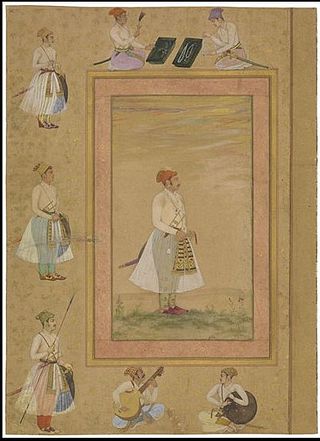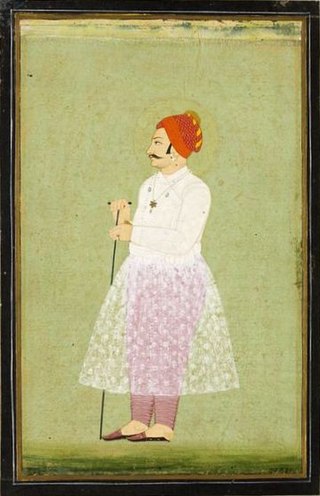Heritage
The Ghasera Fort and Khandar F ort [17] are among the two major forts built by Bargujar Rajput rulers.

The Badgujar / Bargujar / Badgurjar is a clan of Rajputs. [1] They are also a distinct caste in Maharashtra. [2]
Similar to other Rajput clans, the Badgujars also claim descent from the ancient Suryavanshi king Rama. [3] [ better source needed ]
The Bargujars ruled over Rajorgarh, Dausa, Deoti and Ghasira, Macheri. [4] [5] [6] [7] [8] They were expelled from Dausa, Rajorgarh and Deoti by Kachhwaha Rajputs when they migrated to Dhundhar, in 11th century Dulha Rai, won the areas of Dausa and Deoti from the Badgujar Rajputs, who were reduced to feudatory or jagirdars. [9] [10] [11] In 18th century Surajmal with the help of Mughal wazir took the Bargujar stronghold of Ghasera from its ruler Bahadur Singh Badgurjar which was again recovered by Bahadur Singh's son with the help of Imad ul MulK. [12]
Among small petty states ruled by Bargujar Rajputs were Daria Kheri, [13] [ full citation needed ] Kamalpur. [14]
Other Jagirs once controlled by Badgujars Barauli Rao. [15] [16] [ full citation needed ]
The Ghasera Fort and Khandar F ort [17] are among the two major forts built by Bargujar Rajput rulers.

They are mainly distributed parts of present-day Rajasthan, Uttar Pradesh and Madhya Pradesh. [18] [ need quotation to verify ] [19] [ need quotation to verify ]

Amber or Amer, is a city near Jaipur in Jaipur district in the Indian state of Rajasthan. It is now a part of the Jaipur Municipal Corporation.

Alwar is a city located in India's National Capital Region and the administrative headquarters of Alwar District in the state of Rajasthan. It is located 150 km south of Delhi and 150 km north of Jaipur.

Sawai Jai Singh II, was the 29th Kachwaha Rajput ruler of the Kingdom of Amber, who later founded the fortified city of Jaipur and made it his capital. He became the ruler of Amber at the age of 11, after the death of his father, Mirza Raja Bishan Singh, on 31 December 1699.

The Kachhwaha, or Kachhawa is a Rajput clan found primarily in India.

Dausa district is a district in the Indian state of Rajasthan. It is part of the Jaipur division–one of the ten administrative divisions of Rajasthan. The city of Dausa is the district headquarters. Other important cities are Bandikui, Lalsot, and Mahuwa. It is surrounded by Alwar district in the north, Bharatpur in the east, Gangapur in the south-east, Sawai Madhopur in the south, and Jaipur Rural in the west. It has an area of 3,432 km2 (1,325 sq mi) and a population of 1,634,409.

Mirza Raja Ram Singh I was the Raja of the Kingdom of Amber and head of the Kachwaha Rajput clan, succeeding his father Mirza Raja Jai Singh I. He also served as the general of the Mughal Empire and commander-in-chief of its army as well as the Subahdar of Kashmir.
Rajgarh is a town and a tehsil in Alwar district in the Indian state of Rajasthan. Bhangarh, Asia's most haunted place, is also present in Rajgarh, Alwar tehsil. It is a small town set in scenic hills dotted with forts, and features waterfalls, a valley, and the hills of Aravalli.

The Kingdom of Amber, also known as Kingdom of Dhundhar, and Jaipur State, was located in the north-eastern historic Dhundhar region of Rajputana and was ruled by the Kachwaha Rajput clan. It was established by Dulha Rai, possibly the last ruler of the Kachchhapaghata dynasty of Gwalior who migrated to Dausa and started his kingdom there with the support of Chahamanas of Shakambhari in the 12th century. Mostly through 12th to 15th century, the kingdom faced stagnation, sources were scarce. Under its ruler, Raja Chandrasen of Amber became a Sisodia vassal and fought in the Battle of Khanwa under Raja Prithviraj Kachhwaha.

Mirza Raja Bishan Singh was the Kachwaha Rajput ruler of the Kingdom of Amer .He succeeded his grandfather Mirza Raja Ram Singh I since his father Kishan Singh died in the lifetime of his grandfather.He was also the subahdar of the province of Assam from the year 1687 to 1695 in the reigning times of Mughal Emperor Aurangzeb.He is known to have fathered one of the most eminent political icons of 18th century India i.e Sawai Jai Singh II.
Pajawan or Pajjun was the 5th Kachhwaha ruler of the Kingdom of Amber. He belonged to the Kachhwaha Rajput clan who had migrated to Rajputana in the 12th century. He was married to Prithviraj Chauhan's cousin and was a prominent and trusted general of Prithviraj. Pajwan fought 64 important battles in his military career.
Ahirwada was a historic region located between the Parvati and Betwa rivers in Central India or modern Madhya Pradesh. It was between the cities Bhilsa and Jhansi. Historically Ahirwada was ruled by members of the Ahir community.
Raja Askaran was a late sixteenth-century Kachwaha Rajput ruler. Though briefly Raja of Amber, for the majority of his life Askaran was the ruler of Narwar. He along with his sons and grandsons also had a distinguished career as military officers and noblemen under Mughal Emperor Akbar and rose high in his service. He was also the maternal grandfather of Manavati Bai of Marwar consort of Emperor Jahangir and mother of Emperor Shah Jahan,hence maternal great grandfather of Shahjahan.
Kakil or Kankil was a king of the Kachhwaha dynasty and successor of Dulha Rai, who ruled the Dhundhar region with their capital at Khoh in present-day Rajasthan.
Ghasera Fort is a ruined fort in Ghasera village in Nuh district of Haryana state in northern India, which has been notified as a protected monument by the state government. Currently, the majority of the residents of the village are Muslim Meos, though Hindus also live there.
The Battle of Bagru was a military engagement fought between multiple Indian kingdoms in 1748 near the town of Bagru, Jaipur, India. The battle was fought during a succession crisis following the death of Jai Singh II, which left Jaipur without effective Madho Singh defeated ishwari Singh in a 6 day with help of Marathas and kingdom of bundi.
Raja Prithviraj Singh I, also known as Prithvi Singh I, was the 16th-century Kachwaha Rajput ruler of Kingdom of Amber. He was a monarch of strong religious inclinations and during his reign, the Kingdom of Amber became increasingly politically active. He took part in the Rajput alliance against Mughal Emperor Babur, fighting against the latter in the Battle of Khanwa alongside Rana Sanga of Mewar in the year 1527. Three of Raja Prithviraj's sons successively followed him as ruler of Amber, with many of his descendants also populating the kingdom's highest aristocracy in subsequent centuries.
Gaur also known as "Gour" is a Hindu Rajput clan of India. They have ancient ancestry and find mention by James Tod as one of 36 royal races in his book Annals and Antiquities of Rajasthan The Gaur Rajputs once held a prominent position in Ajmer till the time of Prithviraj Chauhan. Gorwar region gets its name from this clan. In later years they lost the territories ruled by them. In 15th century, they fought at least 13 battles with Shekhawats were defeated and were reduced to feudetory or jagirdars in Shekhawati region. The Rajgarh territory was one of the last bastion of Gaur Rajputs during the times of Mughal Emperors, Humayun and Akber, which was lost to Kishan Singh in 17th century. Gaur Rajputs remained allies to Mughal till the time of Aurangzeb, whose political decisions, alienated Rathods, Sisodias, Hadas and Gaur Rajput from Mughals.
Khoh, also known as Khogong, was the capital of the kingdom of Amber which was located in the Dhundhar region of Rajputana. Which was located just five miles to the east of Jaipur city and was ruled by the Chanda clan. Rao Chandrasen Chanda abandoned Mahishmati city and established a kingdom here. It was the capital of the Chandas till the 11th century and of the Kachhawahas from the 11th to the 13th century.
Dulha Rai was the founder of the Kachhwaha dynasty and also the 1st king from this dynasty who ruled the territory of Dhundhar, with his capital at Khoh in present-day Rajasthan. He started his rule from Dausa which he obtained as a dowry from the Chahamanas of Shakambhari. Making Dausa as his base, he started conquering the region of Dhundhar and soon was recognised as the ruler of this region by the Chahamanas after he successfully suppressed the rebellious Bargujar Rajputs.
Meo settlement in this area by the tenth century is recorded by the gazetteers of the United Provinces as also their displacement by Rajput clans such as the Dors, Tomars, Bargujars, and Chauhans.
By the early eleventh century Dulha Rai had wrested Dausa and Deoti from the Badgujar Rajputs and subdued Meenas